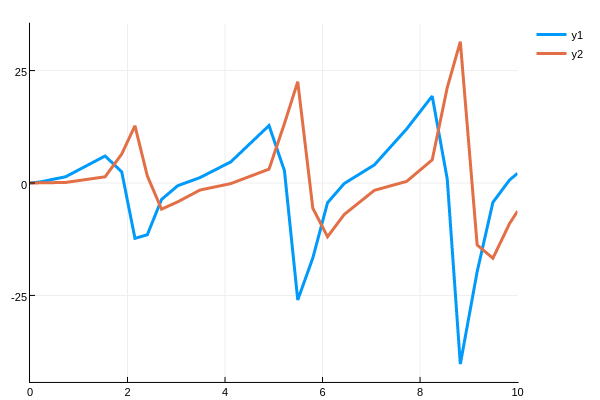Sensitivity Analysis
Sensitivity analysis for ODE models is provided by the DiffEq suite.
Local Sensitivity Analysis
The local sensitivity of the solution to a parameter is defined by how much the solution would change by changes in the parameter, i.e. the sensitivity of the ith independent variable to the jth parameter is $\frac{\partial y}{\partial p_{j}}$.
The local sensitivity is computed using the sensitivity ODE:
where
is the Jacobian of the system,
are the parameter derivatives, and
is the vector of sensitivities. Since this ODE is dependent on the values of the independent variables themselves, this ODE is computed simultaneously with the actual ODE system.
Defining a Sensitivity Problem
To define a sensitivity problem, simply use the ODELocalSensitivityProblem type instead of an ODE type. Note that this requires a ParameterizedFunction with a Jacobian. For example, we generate an ODE with the sensitivity equations attached for the Lotka-Volterra equations by:
f = @ode_def_nohes LotkaVolterraSensitivity begin
dx = a*x - b*x*y
dy = -c*y + d*x*y
end a=>1.5 b=>1 c=>3 d=1
prob = ODELocalSensitivityProblem(f,[1.0;1.0],(0.0,10.0))This generates a problem which the ODE solvers can solve:
sol = solve(prob,DP8())Note that the solution is the standard ODE system and the sensitivity system combined. Therefore, the solution to the ODE are the first n components of the solution. This means we can grab the matrix of solution values like:
x = vecvec_to_mat([sol[i][1:sol.prob.indvars] for i in 1:length(sol)])Since each sensitivity is a vector of derivatives for each function, the sensitivities are each of size sol.prob.numvars. We can pull out the parameter sensitivities from the solution as follows:
da=[sol[i][sol.prob.numvars+1:sol.prob.numvars*2] for i in 1:length(sol)]
db=[sol[i][sol.prob.numvars*2+1:sol.prob.numvars*3] for i in 1:length(sol)]
dc=[sol[i][sol.prob.numvars*3+1:sol.prob.numvars*4] for i in 1:length(sol)]This means that da[i][1] is the derivative of the x(t) by the parameter a at time sol.t[i]. Note that all of the functionality available to ODE solutions is available in this case, including interpolations and plot recipes (the recipes will plot the expanded system).
Since the closure returns a vector of vectors, it can be helpful to use vecvec_to_mat from RecursiveArrayTools.jl in order to plot the solution.
plot(sol.t,vecvec_to_mat(da),lw=3)
Here we see that there is a periodicity to the sensitivity which matches the periodicity of the Lotka-Volterra solutions. However, as time goes on the sensitivity increases. This matches the analysis of Wilkins in Sensitivity Analysis for Oscillating Dynamical Systems.